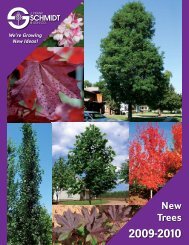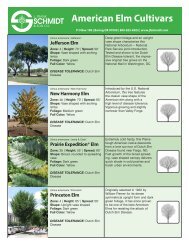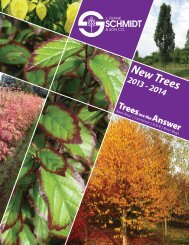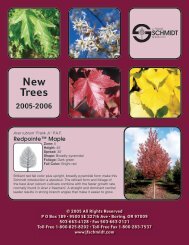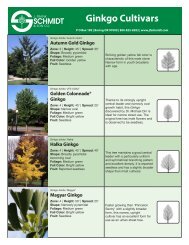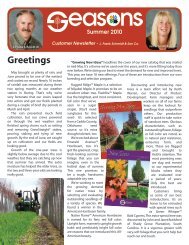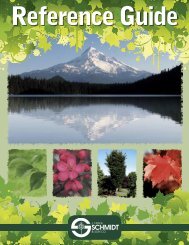You also want an ePaper? Increase the reach of your titles
YUMPU automatically turns print PDFs into web optimized ePapers that Google loves.
Tilia cordata ‘Baileyi’<br />
Shamrock ® Linden<br />
Zone: 4<br />
Height: 40'<br />
Spread: 30'<br />
Shape: Pyramidal,<br />
symmetrical<br />
Foliage: Dark green<br />
Fall <strong>Co</strong>lor: Yellowish<br />
Ulmus parvifolia ‘UPMTF’ PP 11295<br />
Bosque ® Elm<br />
Zone: 6<br />
Height: 45'<br />
Spread: 30'<br />
Shape: Upright pyramidal<br />
to broadly oval<br />
Foliage: Dark green,<br />
glossy<br />
Fall <strong>Co</strong>lor: Yelloworange<br />
A pyramidal form of linden, similar to Greenspire ® ,<br />
but a little faster growing. It branches more<br />
uniformly around the trunk at an earlier age.<br />
Tilia cordata ‘Halka’ PP 10589<br />
Summer Sprite ® Linden<br />
Zone: 4<br />
Height: 16'<br />
Spread: 10'<br />
Shape: Dense,<br />
narrow pyramid,<br />
dwarf<br />
Foliage: Green<br />
Fall <strong>Co</strong>lor: Yellow<br />
Perfect for confined city spaces, this natural<br />
dwarf develops the form of a sheared Christmas<br />
tree.<br />
Accolade ® Elm<br />
Ulmus parvifolia ‘Emer II’ PP 7552<br />
Allee ® Elm<br />
Zone: 5<br />
Height: 50'<br />
Spread: 35'<br />
Shape: Upright vase,<br />
arching<br />
Foliage: Medium<br />
green, glossy<br />
Fall <strong>Co</strong>lor: Yelloworange<br />
to rust red<br />
DISEASE TOLERANCE: Dutch elm disease and<br />
phloem necrosis<br />
The first lace bark elm introduction with a narrow<br />
crown shape, Bosque ® is well shaped for city<br />
street use. Glossy dark green, fine textured foliage<br />
combines with multi-colored exfoliating bark.<br />
Ulmus<br />
Elm<br />
Ulmus japonica x wilsoniana ‘Morton’<br />
Accolade ® Elm<br />
Zone: 4<br />
Height: 70'<br />
Spread: 60'<br />
Shape: Vase shaped<br />
with<br />
arching limbs<br />
Foliage: Glossy, dark<br />
green<br />
Fall <strong>Co</strong>lor: Yellow<br />
INSECT TOLERANCE:<br />
Resistant to elm leaf beetle<br />
DISEASE TOLERANCE:<br />
Dutch Elm Disease and Phloem Necrosis<br />
Arching limbs and a graceful vase shape<br />
characterize this outstanding hybrid elm selected<br />
and tested at Morton Arboretum. Glossy dark<br />
green foliage changes to yellow in the fall and is<br />
resistant to elm leaf beetle feeding. Growth habit<br />
gives good form in the nursery and an ultimate<br />
form like the American Elm.<br />
DISEASE TOLERANCE:<br />
Dutch Elm Disease and Phloem Necrosis<br />
Tall, upright and arching, this cultivar’s growth<br />
habit is unique among U. parvifolia cultivars,<br />
being reminiscent of the grand American Elm.<br />
Its exfoliating bark creates a mosaic of orange,<br />
tan and gray, a beautiful sight on a mature tree.<br />
Discovered by Dr. Michael Dirr of University of<br />
Georgia, Athens.<br />
Ulmus parvifolia ‘Emer I’ PP 7551<br />
Athena ® Classic Elm<br />
Zone: 5<br />
Height: 30'<br />
Spread: 35'<br />
Shape: Broadly<br />
rounded<br />
Foliage: Medium<br />
green, glossy<br />
Fall <strong>Co</strong>lor: Yellowish<br />
DISEASE TOLERANCE:<br />
Dutch Elm Disease and Phloem Necrosis<br />
Bark of a mature tree is a mosaic of orange, tan,<br />
and gray patches, giving it as much interest in<br />
winter as in summer. The canopy is tightly formed.<br />
Discovered by Dr. Michael Dirr of University of<br />
Georgia, Athens.<br />
Allee ® Elm<br />
Ulmus ‘Morton Stalwart’<br />
<strong>Co</strong>mmendation Elm<br />
Zone: 5<br />
Height: 60'<br />
Spread: 50'<br />
Shape: Upright oval<br />
Foliage: Dark green<br />
Fall <strong>Co</strong>lor: Yellow<br />
DISEASE TOLERANCE:<br />
Dutch Elm Disease and Phloem Necrosis<br />
An oval canopy with good foliage quality is<br />
formed by upright spreading and symmetrical<br />
branches. Fast growing but not wild, it is easier<br />
to maintain good form in the nursery than is the<br />
case with most elm cultivars. This is a complex<br />
hybrid of parent species Ulmus wilsoniana,<br />
U. pumila and U. carpinifolia.<br />
© J. <strong>Frank</strong> <strong>Schmidt</strong> & <strong>Son</strong> <strong>Co</strong>.<br />
www.jfschmidt.com<br />
Ulmus - Elm<br />
65



